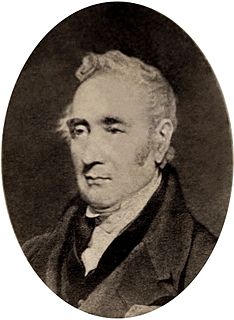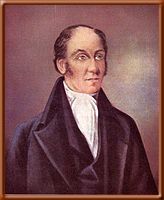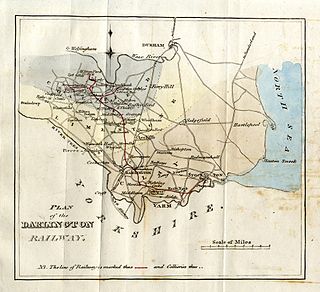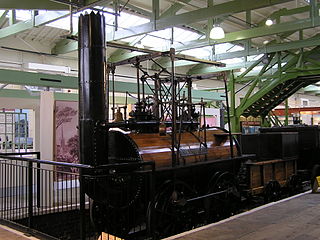
George Stephenson was an English civil engineer and mechanical engineer. Renowned as the "Father of Railways", Stephenson was considered by the Victorians a great example of diligent application and thirst for improvement. Self-help advocate Samuel Smiles particularly praised his achievements. His chosen rail gauge, sometimes called "Stephenson gauge", was the basis for the 4 feet 8+1⁄2 inches (1.435 m) standard gauge used by most of the world's railways.

Wagonways consisted of the horses, equipment and tracks used for hauling wagons, which preceded steam-powered railways. The terms plateway, tramway and dramway were used. The advantage of wagonways was that far bigger loads could be transported with the same power.

Timothy Hackworth was an English steam locomotive engineer who lived in Shildon, County Durham, England and was the first locomotive superintendent of the Stockton and Darlington Railway.

The Liverpool and Manchester Railway (L&MR) was the first inter-city railway in the world. It opened on 15 September 1830 between the Lancashire towns of Liverpool and Manchester in England. It was also the first railway to rely exclusively on locomotives driven by steam power, with no horse-drawn traffic permitted at any time; the first to be entirely double track throughout its length; the first to have a signalling system; the first to be fully timetabled; and the first to carry mail.

The history of rail transport began in the prehistoric times. It can be divided into several discrete periods defined by the principal means of track material and motive power used.

The Stockton and Darlington Railway (S&DR) was a railway company that operated in north-east England from 1825 to 1863. The world's first public railway to use steam locomotives, its first line connected collieries near Shildon with Darlington and Stockton-on-Tees in County Durham, and was officially opened on 27 September 1825. The movement of coal to ships rapidly became a lucrative business, and the line was soon extended to a new port at Middlesbrough. While coal waggons were hauled by steam locomotives from the start, passengers were carried in coaches drawn by horses until carriages hauled by steam locomotives were introduced in 1833.

The Cromford and High Peak Railway (C&HPR) was a standard-gauge line between the Cromford Canal wharf at High Peak Junction and the Peak Forest Canal at Whaley Bridge. The railway, which was completed in 1831, was built to carry minerals and goods through the hilly rural terrain of the Peak District within Derbyshire, England. The route was marked by a number of roped worked inclines. Due to falling traffic, the entire railway was closed by 1967.

The Leicester and Swannington Railway (L&S) was one of England's first railways, being opened on 17 July 1832 to bring coal from collieries in west Leicestershire to Leicester.

The Swansea and Mumbles Railway was the venue for the world's first passenger horsecar railway service, located in Swansea, Wales, United Kingdom.

The North Tyneside Steam Railway and Stephenson Steam Railway are visitor attractions in North Tyneside, North East England. The museum and railway workshops share a building on Middle Engine Lane adjacent to the Silverlink Retail Park. The railway is a standard gauge line, running south for 2 miles (3.2 km) from the museum to Percy Main. The railway is operated by the North Tyneside Steam Railway Association (NTSRA). The museum is managed by Tyne and Wear Archives and Museums on behalf of North Tyneside Council.
Phoenix Row incorporating Belts Gill and Softley Dene Farm is a hamlet of about 30 houses in County Durham, in England. It is situated half a mile north of Low Etherley and 2.5 miles west of Bishop Auckland.

Shildon is a town and civil parish in County Durham, in England. The population taken at the 2011 Census was 9,976. It is situated 2 miles (3.2 km) southeast of Bishop Auckland, 11 miles (18 km) north of Darlington, 13 miles (21 km) from Durham, 23 miles (37 km) from Sunderland and 30 miles (48 km) from Newcastle upon Tyne.

Locomotion No. 1 is an early steam locomotive that was built in 1825 by the pioneering railway engineers George and Robert Stephenson at their manufacturing firm, Robert Stephenson and Company. It became the first steam locomotive to haul a passenger-carrying train on a public railway, the Stockton and Darlington Railway (S&DR).
The Bolton and Leigh Railway (B&LR) was the first public railway in Lancashire, it opened for goods on 1 August 1828 preceding the Liverpool and Manchester Railway (L&MR) by two years. Passengers were carried from 1831. The railway operated independently until 1845 when it became part of the Grand Junction Railway.
The Kilmarnock and Troon Railway was an early railway line in Ayrshire, Scotland. It was constructed to bring coal from pits around Kilmarnock to coastal shipping at Troon Harbour, and passengers were carried.
The history of rail transport in Great Britain to 1830 covers the period up to the opening of the Liverpool and Manchester Railway, the world's first intercity passenger railway operated solely by steam locomotives. The earliest form of railways, horse-drawn wagonways, originated in Germany in the 16th century. Soon wagonways were also built in Britain. However, the first use of steam locomotives was in Britain. The invention of wrought iron rails, together with Richard Trevithick's pioneering steam locomotive meant that Britain had the first modern railways in the world.

The Whitby and Pickering Railway (W&P) was built to halt the gradual decline of the port of Whitby on the east coast of England. Its basic industries—whaling and shipbuilding—had been in decline and it was believed that opening transport links inland would help regenerate the town and port.
The Stanhope and Tyne Railway was an early British mineral railway, that ran from Stanhope in County Durham, to South Shields at the mouth of the River Tyne. The object was to convey limestone from Stanhope and coal from West Consett and elsewhere to the Tyne, and to local consumers. Passengers were later carried on parts of the line.
The Brampton railway was a mineral railway built in 1798 to bring coal from workings on Tindale Fell to staiths at Brampton. It was a development of short sections of earlier wooden railways.













